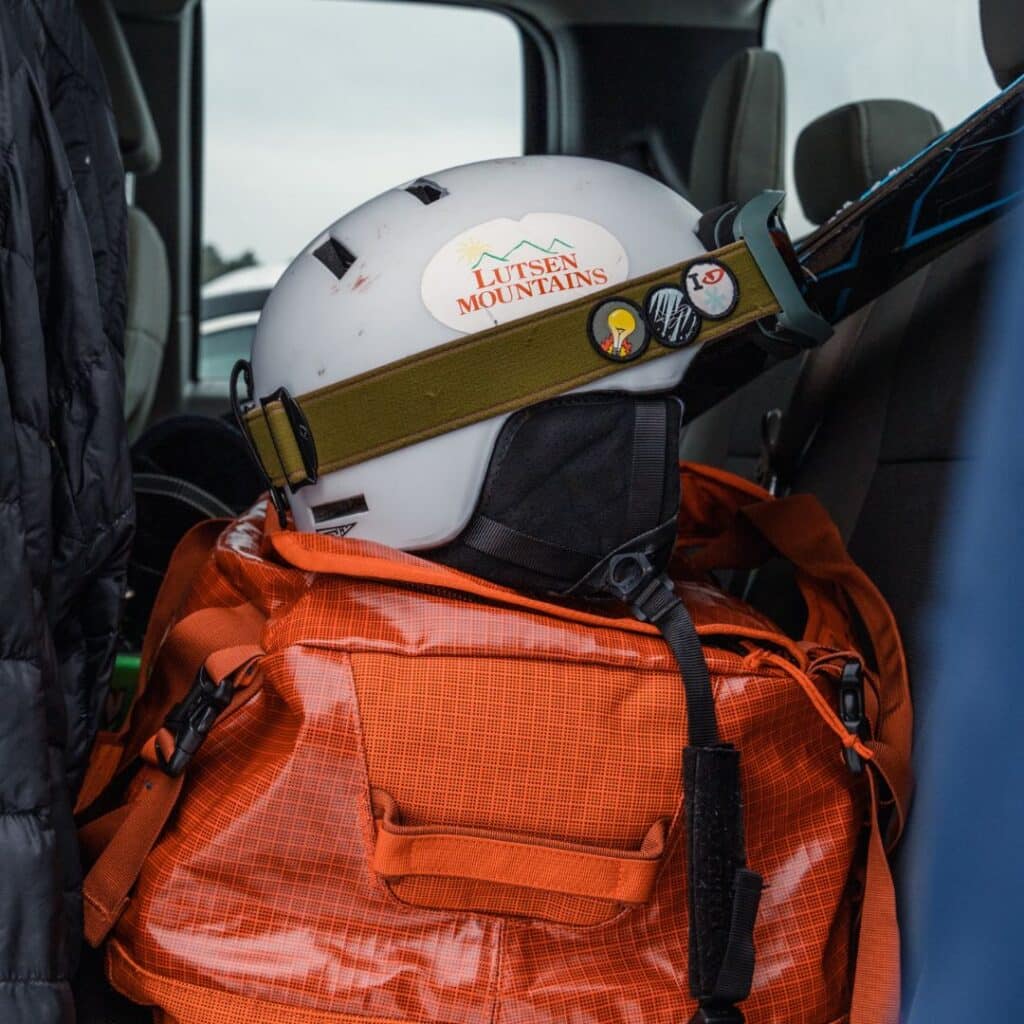That's La Plagne
Top Tips on Travelling with Skis and Snowboards: 2023/24

It’s a question I get all the time: how to travel with skis and snowboards? Or, can I take my skis on a plane? And can I take my ski boots as hand luggage on a flight?
Well I'm excited to share my tried-and-true advice on navigating the world of travelling with ski and snowboard gear. Plus, I’ve dived into the policies from most of the larger European airlines to find out exactly what you can and can’t fly with or take as hand luggage.
With these tips, I’ll help you master the art of travelling with your ski and snowboard gear like a pro.
Join my community newsletter to get regular updates, insider info, and special discounts.
Is travelling with your own ski gear worth it?
When it comes to ski or snowboard gear, you might be wondering if it's worth the effort to travel with your own. The answer? It depends. If you're committed to the sport and find comfort in using your gear, buying and travelling with it can enhance your experience. However, rental ski equipment is also a convenient option, especially for beginners or those looking to avoid the hassle of transporting equipment.
It’s also true that most ski schools and ski equipment rental stores have the top-end ski gear every year. So by renting ski equipment in resort, you actually get to experience higher quality ski gear than you might actually buy yourself.
Do you need to buy your own ski equipment?
How to prioritise Key Gear Items
If you decide to invest in ski or snowboard gear, prioritise essential items over the more “generic” or items that you can rent easily in ski resorts. Most ski experts will agree that if you are looking to buy equipment, look at buying ski boots – or snowboard boots – before the skis or snowboard. The boots are where you will gain the most in comfort and performance on the mountain.
As mentioned above, you can easily rent high-end skis and snowboards from most rental stores.
Other items you might need to look into buying are:
- Goggles or good sunglasses
- Ski clothing: Salopettes, ski jackets and base layers
- Ski socks: well worth investing in and not just using generic tube socks
I have a great article on ski holiday packing which will help with this. But also remember that you can rent a lot of this ski gear as well from companies like EcoSki or buy secondhand from sites like WhoSki.com
Do beginners need to buy ski equipment?
For beginners, renting equipment initially might be a practical choice. It allows you to get a feel for skiing or snowboarding before committing to purchasing gear. Most ski equipment rental stores will offer ski rental packages based on ability, so for example, bronze (beginner) to platinum (advanced).
When renting equipment from ski hire companies, you can also take equipment back to the shop and change it for other makes and models. It can be hard to know what size boots you actually need, or how different skis will actually feel on the snow. I learned this the hard way when I bought snowboard boots that were far too big, but they felt “comfortable” in the shop. I also bought a super cheap pair of ski goggles from a random highstreet sports shop because they were pink and looked good – they were not good at all!
Waiting until you are in resort to get some experience can be well worth it.
Differences between ski and snowboard bags
Ski bag vs snowboard bags
Dedicated ski or snowboard bags are designed to protect your gear during travel. They come in various sizes to accommodate different equipment lengths and styles. I’ll explore them in more detail below. But these are the main “oversized” bags that you will see people travelling with on their ski holiday.
Ski boot bags
Ski boot bags are a must-have for storing and transporting your boots. They help keep your boots organised and protected. They are smaller, just large enough for a pair of ski boots and some small accessories. They are soft-shell bags, providing little protection from hard knocks.
Ski helmet bags
While not as common, ski helmet bags can be beneficial for keeping your helmet safe from scratches and impacts during travel. Often just a soft drawstring bag, providing little protection from hard knocks, but from scratches. They are similar to ski goggle bags in material and strength.
Comparing ski bag styles: pros and cons
Hard case ski bags
Pros: Excellent protection, ideal for delicate gear, can hold multiple pairs of skis.
Cons: Bulky, heavier, can be more expensive.
A hard case ski bag, also known as a ski travel case or ski box, is a specialised piece of luggage designed to protect your ski equipment during transportation, particularly when you're travelling by air. Unlike soft ski bags, which are typically made of durable fabric and padding, hard case ski bags are constructed with rigid materials such as plastic, aluminium, or other hard-wearing materials.
Here are some key features and benefits of a hard case ski bag:
- Rugged Protection: The primary purpose of a hard case ski bag is to provide superior protection for your skis and snowboarding equipment. The hard shell construction shields your gear from impacts, drops, and rough handling during travel.
- Durability: These bags are built to withstand the rigours of air travel and other forms of transportation. They are resistant to punctures, tears, and other damage, ensuring your equipment remains intact.
- Security: Many hard case ski bags come with built-in locking mechanisms, providing an extra layer of security for your valuable gear. This can help deter theft and tampering.
- Padding: Inside the hard shell, there is often foam padding or other cushioning materials to further protect your skis and snowboard from scratches and impacts.
- Capacity: Hard case ski bags are available in various sizes to accommodate different types of equipment, including skis, snowboards, and poles. Some models can even fit multiple pairs of skis and snowboards.
- Wheels and handles: To make transportation easier, many hard case ski bags are equipped with wheels and handles, allowing you to roll them through airports and other travel hubs.
- Customisation: Some hard case ski bags have adjustable interiors or padding that can be customised to fit your specific gear, ensuring a snug and secure fit.
- Weather Resistance: While not entirely waterproof, many hard case ski bags offer a degree of weather resistance, helping to protect your gear from rain and snow during transit.
Hard case ski bags are particularly popular among serious skiers and snowboarders who travel frequently or have expensive equipment they want to safeguard. While they offer excellent protection, it's important to consider their weight and size when travelling, as they can be bulkier and heavier than soft ski bags. Additionally, they tend to be more expensive than their soft counterparts, but the investment can be well worth it for those who prioritise equipment safety.
Soft ski bags
Pros: Lightweight, easy to store when not in use, often have multiple compartments.
Cons: Less protection compared to hard cases, may not fit all gear types.
A soft ski bag is a type of luggage designed to transport and protect your ski equipment, including skis, poles, and sometimes even boots and other gear. Unlike hard case ski bags, which have rigid shells, soft case ski bags are made from durable fabrics and materials, offering a more flexible and lightweight option for carrying your equipment.
Here are some key features and benefits of a soft case ski bag:
- Flexibility: Soft case ski bags are made from materials like nylon or polyester, which allow the bag to flex and conform to the shape of your equipment. This flexibility makes it easier to pack and fit gear of different sizes.
- Lightweight: Compared to hard case ski bags, soft bags are generally lighter, which can be an advantage when it comes to luggage weight limits imposed by airlines.
- Padding: Soft ski bags typically have padding or foam lining to protect your gear from scratches and minor impacts during transportation. However, some ski bags will have no padding in them at all, making them super light but you will need to pad out your ski gear if protection is needed.
- Variety of Sizes: Soft ski bags come in various sizes to accommodate different lengths of skis and snowboards. Some bags are designed to hold multiple pairs of skis, making them versatile for group trips.
- Accessibility: Most soft ski bags have multiple zippered compartments and pockets for easy access to your equipment, as well as for organising small items like gloves, goggles, and ski clothing.
- Portability: These bags often come with carrying handles and adjustable shoulder straps, making them relatively easy to transport, especially for short distances.
- Affordability: Soft ski bags tend to be more budget-friendly than hard cases, making them a popular choice for recreational skiers and snowboarders.
- Compact Storage: When not in use, soft ski bags can be folded or rolled up, taking up less space in your storage area.
While soft case ski bags provide good protection for your equipment against scratches, dirt, and minor impacts, they may not offer the same level of protection as hard cases against more severe damage during air travel. If you have particularly fragile or valuable gear, you might want to consider a hard case ski bag for added protection. However, for most skiers and snowboarders, a quality soft case ski bag is more than sufficient for safely transporting and storing their equipment.
I have always had a soft snowboard bag and found it has plenty of storage for my snowboard gear, comfortably fitting a snowboard, bindings, boots, helmet, plus all my ski clothes and layers.
Ski bags with wheels
Pros: Easy manoeuvrability, ideal for long distances, versatile.
Cons: Limited protection for delicate gear, may not fit in small spaces.
A ski bag with wheels, as the name suggests, is a type of ski bag equipped with wheels and could be both a hard case or soft case ski bag. The wheels make transporting your skiing or snowboarding equipment more convenient, especially when navigating through airports, train stations, or other transportation hubs. These bags are designed to accommodate skis, snowboards, and sometimes additional gear such as boots and poles.
Ski bags with wheels are a popular choice among skiers and snowboarders who frequently travel to ski resorts. They not only save you from the hassle of lugging heavy bags but also protect your gear and make the overall travel experience more convenient. When choosing a ski bag with wheels, be sure to consider the size and capacity you need based on your specific gear requirements.
I have always opted for a snowboard bag with wheels because it’s surprising how heavy your ski gear can get: easily 15kgs without adding in any clothes. Whilst it can be difficult to manoeuvre a ski bag with wheels plus a suitcase on wheels, I’d much rather have the choice for ease of access than not.
Ski sleeves
Pros: Lightweight, minimal storage space required, often budget-friendly.
Cons: Limited protection, best for short-distance travel.
A ski sleeve, or snowboard sock, is also known as a ski cover or ski bag, is a simple protective covering designed to safeguard your skis from minor damage, dirt, and moisture during transportation or storage. Ski sleeves are typically made from very lightweight, flexible materials and come in a variety of shapes and sizes to accommodate different types of skis.
It's important to note that ski sleeves provide the most basic protection and are suitable for short trips or when storing your skis between ski outings. However, if you plan to travel by air or transport your skis over longer distances, you should consider investing in a more durable and padded ski bag, which offers better protection against rough handling and impacts.
Comparing different ski holiday travel with ski bags
What is the best way to fly with ski bags?
If you are flying with skis or snowboards, then you need to invest in either a soft or hard case ski bag. Ensure you adhere to airline regulations for checked baggage. Most airlines treat ski bags as regular checked luggage. Meaning, you can pack a ski or snowboard bag as your 1 piece of luggage. Or you may choose to pay for an additional piece of luggage for your ski bag (i.e. in addition to your suitcase) and this is more common.
Ski boot bags might qualify as carry-on, but it's recommended to check with the airline.
Ski helmets can be packed either in hold luggage or as carry-on. I often just clip my ski helmet to my hand luggage.
You can find out more about the different airline policies in these articles:
- Mastering the Art of Flying Easyjet with Ski Gear: 2023/24
- Skiing with British Airways: Your Essential Guide to Bringing Your Gear: 2023/24
- Jet2 Ski Flights: Pack Smart for Your Ski Trip: 2023/24
- Ryanair ski flights: Travel with Your Ski Gear: 2023/24
Driving to a ski holiday with skis or snowboards
When driving to a ski holiday, it can be tempting to pack the car to the brim, after all there’s no weight limit, right? Well just remember that the heavier the car, the more fuel you will use. Plus of course, your comfort in the car. Depending on the size of your car versus the length of your skis or snowboards, you may be limited as to whether they will fit in your boot space or on the back seat. It’s always worth measuring this out and not just assuming everything will fit – I’ve been caught out by this before!
It may be worth taking advantage of roof racks or ski racks to securely transport your gear. In ski resorts, this is what you will see most locals doing as it also means when you use your car in a resort, you don’t need to worry about snow melting off your skis into the interior of your car. I would recommend investing in ski straps to bundle and protect your skis during the journey. Ski straps basically keep your skis firmly secured to one another and not moving loosely around.
Taking a ski transfer with ski bags
For most ski transfer companies, this is their bread and butter! However, it is always a good idea to confirm that you will be travelling with ski gear. For example, if you have a private minibus collecting 8 of you, confirm with the company that you will have 8 pieces of luggage plus e.g.,4 ski bags. It’s always best to confirm this in advance rather than arriving to find there is no space.
Taking the train with ski or snowboard bags
Whilst there is no direct train from the UK to the mountains any more, there are options to transit through Lille. The train change is straightforward, meaning you don’t need to move across town with multiple suitcases and ski bags. However, I would still recommend investing in ski bags with wheels!
French trains often have designated areas for suitcases, including ski and snowboard gear. You can confirm with the train company in advance and you are often asked to confirm a seat reservation in advance, meaning you can select one close to the luggage spaces.
That’s La Plagne and how to travel with ski equipment
With these top tips, you're well-equipped to embark on a family ski holiday with your favourite ski gear safely in tow. The beauty of the mountains awaits, and your well-prepared equipment ensures you'll be ready to carve your way through the slopes. Whether you opt for rentals or choose to travel with your own gear, the thrill of the ski holiday experience remains unmatched.
FAQs about Ski and Snowboard Bags
- Can you take ski boot bags as hand luggage on a flight?
In most cases, ski boot bags are considered cabin luggage, but regulations can vary. Check with your airline for specific guidelines. - What are the typical ski bag dimensions?
Ski bag dimensions can vary, but a standard ski bag is around 200 cm in length. If you are flying, check the policy in regards to sports equipment, as the limit is often 190cm in length. - How many pairs of skis fit in a ski bag?
Depending on the bag's size, you can fit 1-2 pairs of skis comfortably. - Is it worth having a ski bag with wheels?
Ski bags with wheels offer convenience, especially when navigating airports or train stations. I would always recommend opting for a ski bag with wheels if you can. - Do airlines charge extra for skis?
Some airlines might charge extra for oversized baggage like ski bags. Check the airline's policy before you travel. See my airline-specific reviews for more information: - How do I prepare skis for travel?
Clean and dry your skis before packing them in a ski bag. Use padding or bubble wrap to protect bindings. Make sure edges are well protected as they can be sharp and damage other items in your bag.
Can I take a ski helmet as hand luggage on a flight?
Generally, ski helmets can be taken as carry-on luggage, but it's wise to confirm with your airline beforehand.





4 Responses